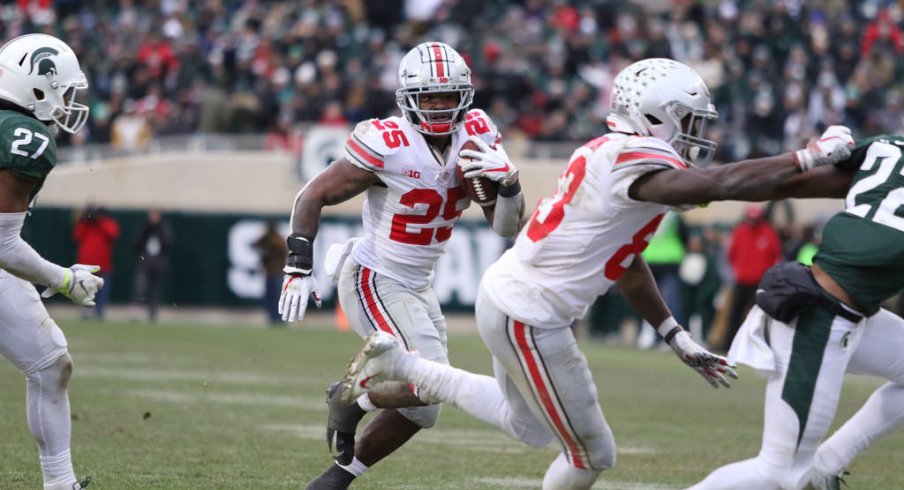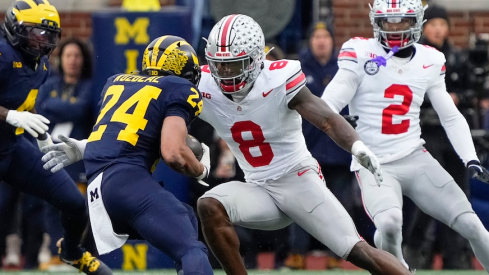"It was November football at Michigan State." - Urban Meyer
Saturday's top-25 contest in East Lansing wasn't a pretty one. There's no doubt about it.
Unlike Ohio State's early season tussles that regularly saw scores eclipse the 40-point mark, their late-season matchup with Mark Dantonio's squad reinforced the Big Ten's stereotype of physical, plodding football. While the utter lack of big plays may not have been pleasing to the eye, the Buckeyes showed a great deal of toughness and discipline in their 26-6 victory, possibly answering a number of lingering questions in the process.
Also unlike OSU's September opponents, the Spartans are very familiar with their divisional rivals from Columbus, engaging in a schematic chess match that only tipped in favor of Urban Meyer and his staff over the past few seasons. This familiarity allowed Dantonio's defense to enter the game with an effective game plan that stymied their opponents for most of the first two quarters.
"I just want to say I have tremendous respect for their program and coach Dantonio, we knew exactly what this would be, and it went that way," Meyer said following the game. "It was November football at Michigan State. Mike Weber ran for 100 yards, and I would have to say 75% of those were post-contact yards so he ran really hard. Everything about going against that defense was really hard."
Though statistical models likely won't be impressed by the Buckeyes' rushing performance, tallying 154 yards on 45 carries, the story of the Ohio State ground game in this contest may hold the key to success throughout the rest of the season.
By now, everyone reading this is aware of the team's systematic issues with their run game, struggling to replace the threat posed by a running quarterback like J.T. Barrett or Braxton Miller. Without such a threat this fall, the unit has often been stymied by unblocked defenders near the line of scrimmage, especially on the edges.
Putting such defenders in a bind is a core philosophy of Meyer's offense going all the way back to his first job at Bowling Green, but one his team has struggled to achieve.
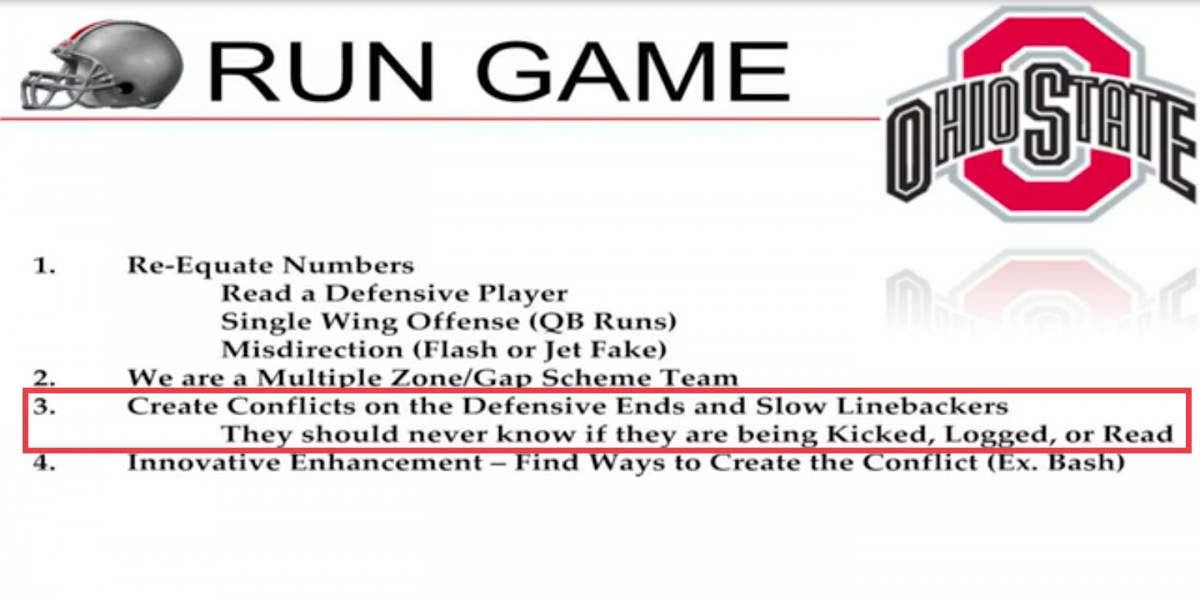
As they took the field in Spartan Stadium, this same problem reappeared immediately as star defensive end Kenny Willekes set up camp in the Buckeye backfield throughout the first quarter. With a clear sense of the snap count, the junior defender consistently slanted inside of the offensive tackle across from him, letting the alley defender (known as the STAR in the MSU system) fill the C-gap outside.
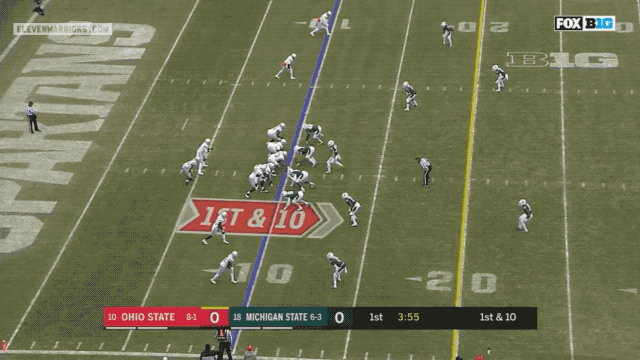
With such a quick first step, Willekes was able to shut down the tight zone blocking schemes that Meyer's staff called throughout much of the first half. The result was a putrid 14 rushing yards on 16 carries through two quarters for the Buckeyes.
But while the numbers may not show it, Ohio State eventually found some success by with a pair of new wrinkles that had debuted the week prior. Against Nebraska, the Buckeyes regularly called for Jet motion, leaving the front-side end unblocked knowing he wouldn't be fast enough to corral the speedy Parris Campbell as he took a touch pass from Dwayne Haskins.
Along with a varied snap count that kept Willekes from jumping the snap, Campbell's motion held the end long enough to both free up the inside game a bit more as well as spring the slot receiver for an easy swing pass to pick up yardage outside.
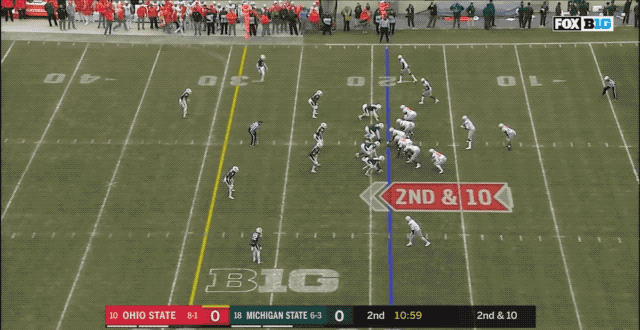
Once near the red zone, that same motioned threat along with a heavy personnel group that featured three tight ends and a lead block from the running back gave Campbell the advantage on the edge and able to run right past Willekes before turning upfield for six.
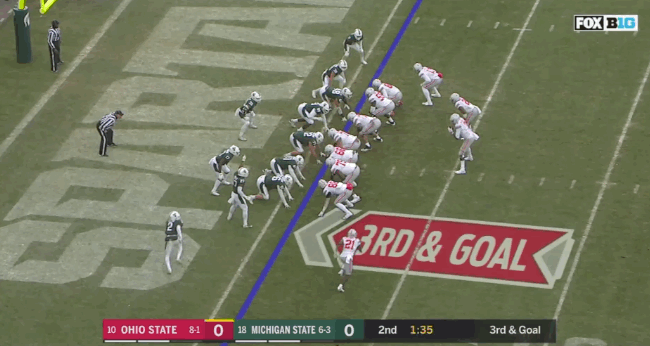
With the Spartan game plan still focused on stopping the inside run game, the Buckeyes seemed more than happy to attack the edges. With Willekes often lined up to the wide side of the field, Ohio State put multiple receivers to the boundary, often in bunch formations to create multiple extra gaps, and ran away from him the Spartan STAR.
Though they attempted this tactic via multiple concepts, the outside zone scheme brought in by Kevin Wilson one year ago proved most successful. After the Ohio State offensive line struggled at times in the first half, they seemed far more comfortable moving laterally with the help of numerous key blocks from tight ends Luke Farrell and Rashod Berry as well as receivers Terry McLaurin and Johnnie Dixon.
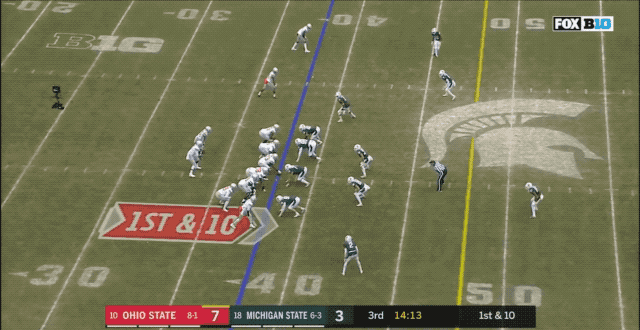
"To be honest, I really think it came down to us being tough down the stretch," McLaurin told the media following the win. "We did not get tired and our offensive line was moving them off the ball when we needed first downs. We picked up some big first downs at the end."
| Quarter | Avg YPC |
|---|---|
| 1st | 3.64 |
| 2nd | 4.20 |
| 3rd | 4.68 |
| 4th | 4.58 |
This shift in approach may seem subtle, but in a game dominated by field position thanks to the outstanding efforts of punter Drue Chrisman, gaining 58 yards on 10 third-quarter carries solidified the momentum in Ohio State's favor. That play-calling tweak has become a calling card for this year's Buckeye squad, as they average more yards-per-carry in the third quarter than any other.
In the fourth quarter, however, the Buckeyes finally unveiled their final wrinkle - replacing Haskins with backup Tate Martell to run the option. While MSU co-defensive coordinator Mike Tressel revealed that he and his team had prepared for such a look, the OSU offense moved the ball on the handful of snaps in which Martell was on the field.
While he had one designed carry in the second quarter on the play prior to Campbell's touchdown, Martell's presence made a bigger difference in the final quarter of play. With two tight ends both lined up to the field, Martell read the boundary end in a variation of the Crunch split-zone option, called Bible by the OSU coaches.

This concept appears to be a favorite of Wilson and Ryan Day, as it's the same one that sprung Haskins for his only rushing touchdown of the season against TCU. But Martell has proven to be a far more effective runner, forcing the Spartans to respect his presence in the option game while Farrell and the receivers set key blocks to the opposite side, all of which helped spring Weber for solid gains.
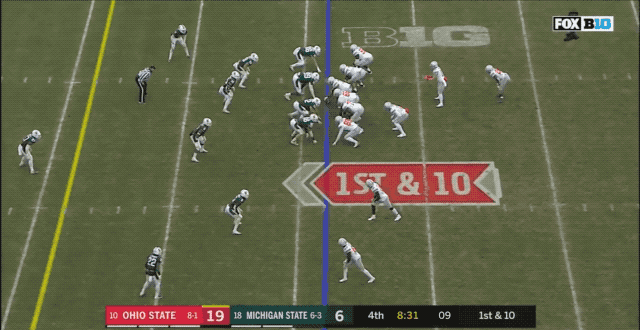
These second-half adjustments led to Weber's second 100-yard performance of the season and made him only the third such runner to do so against the Spartans stingy run defense, which still leads the nation in yards-allowed-per-game. But such a performance won't cut it against the Spartans' in-state rivals when they come to Ohio Stadium in two weeks.
The Buckeyes were lucky to get away with waiting until the second half to make plays against one ranked team from the Great Lakes state. That won't happen the next time.
